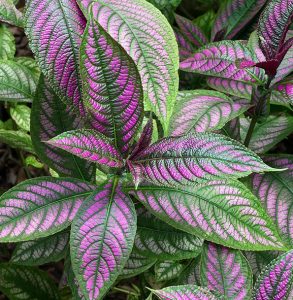How to Care for a Persian Shield Plant
Could you tell me how to care for a Persian Shield plant (Strobilanthes dyerianus).
Hi Doug,
I really like this plant with its iridescent, green-veined purple leaves. The key to success is warm temperatures and high humidity. Here are some care tips.

Light: A Persian Shield plant needs bright indirect light to maintain the vibrant colors; no direct afternoon sun or the leaves may be damaged. The plant becomes thin and leggy when there is not enough light.
Water: Keep the soil barely moist, watering when the top few inches of soil are dry. Spotting occurs on the leaves o a Persian Shield plant if cold water is splashed on them (like a poinsettia). Water less in the fall and winter when the plant is not actively growing.
Plant Food: Do not fertilize a Persian Shield plant during the fall and winter. In the spring and summer, when the plant is actively growing, feed every two weeks with a balanced plant food diluted to 1/2 the recommended strength.
Pests: Whitefly and aphids
Humidity: Persian Shield plants requires humidity to grow well. Leaves dry up and fall off in low humidity. You can mist the leaves, but will need to use rain water or distilled water. Water containing chemicals such as chlorine or water that has passed through a softener damages the leaves. I recommend placing the plant on a wet pebble tray if the air in your home is very dry. Be sure the plant is sitting on the pebbles and not in the water.
Temperature: Likes warm temperatures above 60°F (15.6°C)
Flowers: A Persian Shield plant has beautiful leaves but the flowers are rather inconsequential. You can put the plant outside for the summer to encourage flower spikes, but be sure to bring the plant indoors before the temperature drops below 60°F (15.6°C)
Propagation: Use 2″-3″ stem tip cuttings. Remove the section from the top of a healthy stem just below a leaf node.
Soil: A Persian Shield plant grows well in a rich soil that drains quickly.
Pot Size: Repot annually when the plant is young. As the plant matures, repot every other year. A Persian Shield is a fast growing plant. If it becomes too large, the best way to control its size is by pruning the roots.
Pruning: Pinch back new growth if the plant becomes leggy and you’d like it to be bushier.
Toxicity: Slightly poisonous with a #1 toxicity level
